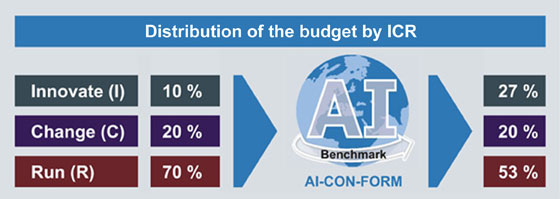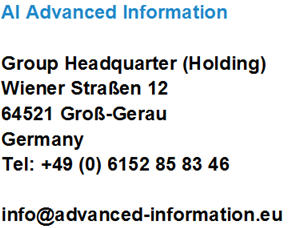AI benchmarks not only focus on efficiency ("Are we doing it right?") but also look into effectiveness ("Are we doing the right thing?")
Modern Benchmarking
More resources for new projects and innovations
New projects every year! An ever growing in-house IT, but operational IT costs must be reduced. Today every CIO is asked to reduce operational resources in favour of new projects. A benchmark not only creates transparency and determines the relationship of your IT to the competition, but it also frees up resources for new projects / innovations.

In the example shown, the AI Controlling Format saves 25% of the "run-the-shop" budget (an average).
A benchmark provides the basis for a higher IT business value.
Full Time Equivalents (FTEs) and budget are not rationalized away after the benchmark, but made available!
Advanced Information offers methodically leading benchmarks and helps you to implement Best Practices. This is how you gain a competitive advantage.
Optimized
by controlling dimension
- Processes / Operational concepts
- Capacity
- Quality
- Quantity
- Costs / Prices
- Architecture
by area
- Data networks
- Voice networks
- Call Centre
- Desktop Services
- Server
- Storage
AI distinguishes between cost and price benchmarks, but also offers a combined view of both:
Cost Benchmark:
- Specifications (performance catalogue)
- Target (service levels) and actual quality (measured values)
- Framework conditions (complexity)
- Input quantities (e.g. number of installed ports)
- Costs and resources (such as personnel services)
- Output quantities (e.g. number of supported employees / users / customers)
- Billing model
- Process analysis
- Highlighting technological issues
- Development of concrete recommendations for decision support
Price Benchmark:
- Specifications (performance catalogue)
- Target (service levels) and actual quality (measured values)
- Framework conditions (complexity)
- Input quantities (e.g. number of installed ports)
- Costs and resources (such as personnel services)
- Output quantities (e.g. number of supported employees / users / customers)
- Analysis of pricing model and prices
- Analysis of price model framework
- (Application of non-linear pricing)
- Price modelling / Pricing
- Analysis of margins or gross profits
- AI has extensive leading know-how in non-linear pricing
- Development of concrete recommendations for decision support
- Identify market opportunities – Secure and increase turnover
Challenges:
- Are costs, quality and performance transparent?
- Where is the IT organization today compared to the market or competitors?
- Do the processes reflect Best Practices?
- What performance improvements can be made?
- What cost reductions are possible without the loss of performance or quality? - Efficiency
- Does IT performance and quality meet business requirements? - Effectiveness
Customer benefits:
- Reduce costs by an average of more than 20%
- Quick wins in the procurement area
- Medium-term improvements (cost, performance, quality, complexity) in processes, organization and personnel
- Process improvements are on average more than 30%
- Reliable solutions from four perspectives - minimizing risk

